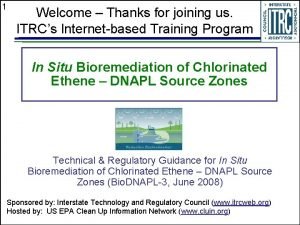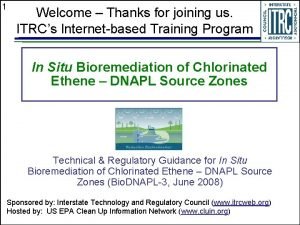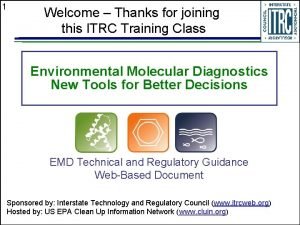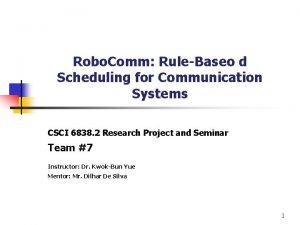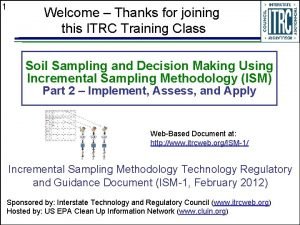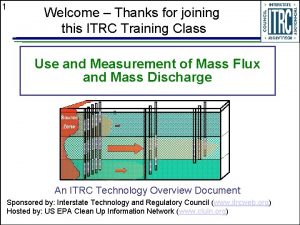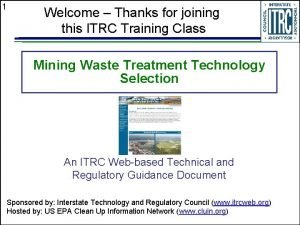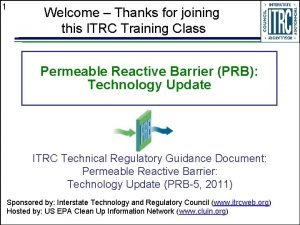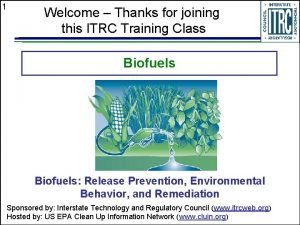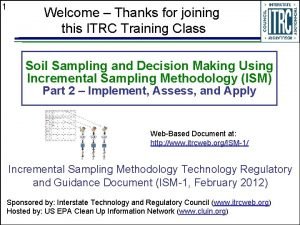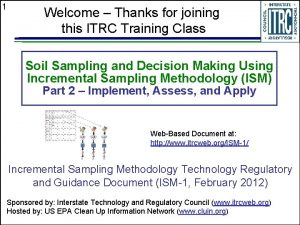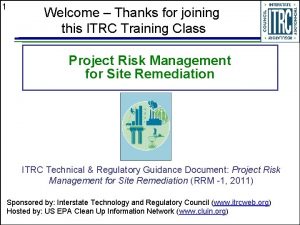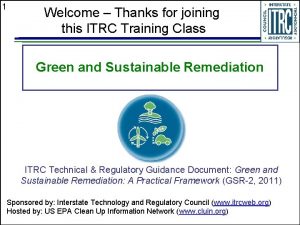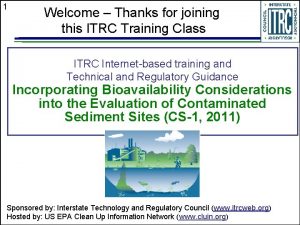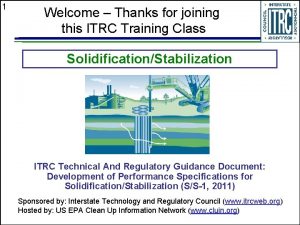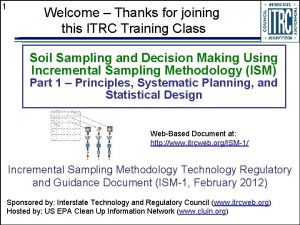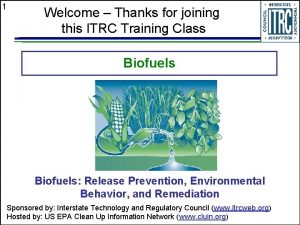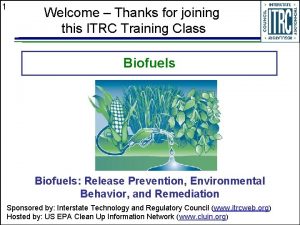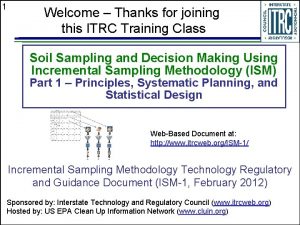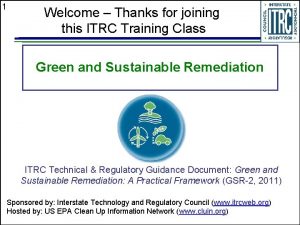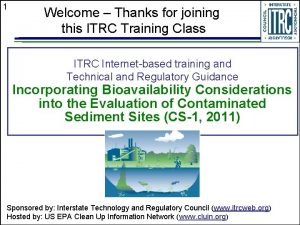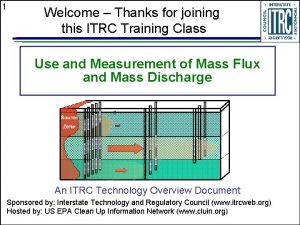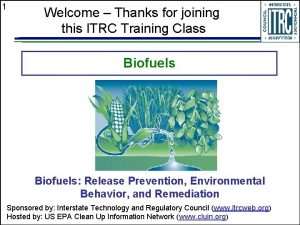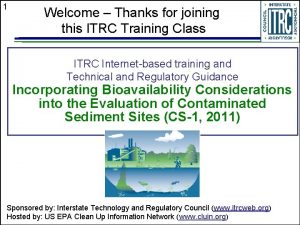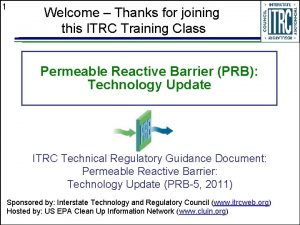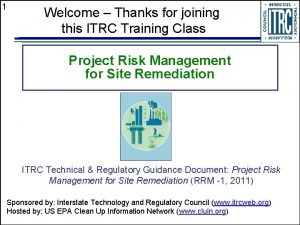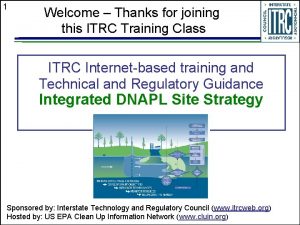1 Welcome Thanks for joining this ITRC Training




























































































- Slides: 92

1 Welcome – Thanks for joining this ITRC Training Class Solidification/Stabilization ITRC Technical And Regulatory Guidance Document: Development of Performance Specifications for Solidification/Stabilization (S/S-1, 2011) Sponsored by: Interstate Technology and Regulatory Council (www. itrcweb. org) Hosted by: US EPA Clean Up Information Network (www. cluin. org)

2 Housekeeping u Course time is 2¼ hours u Question & Answer breaks • Phone - unmute *6 to ask question out loud • Simulcast - ? icon at top to u Move through slides • Arrow icons at top of screen • List of slides on left u Feedback form available from last slide – please complete before leaving u This event is being recorded type in a question u Turn off any pop-up blockers Download slides as PPT or PDF Go to slide 1 Move back 1 slide Move forward 1 slide Go to last slide Go to seminar homepage Submit comment or question Report technical problems Copyright 2012 Interstate Technology & Regulatory Council, 50 F Street, NW, Suite 350, Washington, DC 20001

3 ITRC Disclaimer u This material was sponsored by an agency of the United States Government. The views and opinions of authors expressed herein do not necessarily state or reflect those of the United States Government or any agency thereof and no official endorsement should be inferred. u The information in ITRC Products was formulated to be reliable and accurate. However, the information is provided "as is" and use of this information is at the users’ own risk. Information in ITRC Products is for general reference only; it should not be construed as definitive guidance for any specific site and is not a substitute for consultation with qualified professional advisors. u ITRC Product content may be revised or withdrawn at any time without prior notice. u ITRC, ERIS, and ECOS make no representations or warranties with respect to information in its Products. ITRC, ERIS, and ECOS will not accept liability for damages of any kind that result from acting upon or using this information. u ITRC, ERIS, and ECOS do not endorse or recommend the use of specific technology or technology provider through ITRC Products.

4 ITRC (www. itrcweb. org) – Shaping the Future of Regulatory Acceptance u Host organization u Network • State regulators u • • § All 50 states, PR, DC • Federal partners u DOE DOD EPA • ITRC Industry Affiliates Program • Academia • Community stakeholders Wide variety of topics Technologies Approaches Contaminants Sites Products • Technical and regulatory guidance documents • Internet-based and classroom training

5 ITRC Course Topics Planned for 2013 – More information at www. itrcweb. org Popular courses from 2012 u u u u New in 2013 Decision Framework for Applying Attenuation u Environmental Molecular Processes to Metals and Radionuclides Diagnostics Development of Performance Specifications u Biochemical Reactors for Solidification/Stabilization Mining-Influenced Water Green and Sustainable Remediation u Groundwater Statistics and Integrated DNAPL Site Strategy Monitoring Compliance LNAPL 1: An Improved Understanding of LNAPL Behavior in the Subsurface 2 -Day Classroom Training: LNAPL 2: LNAPL Characterization and u Light Nonaqueous-Phase Recoverability - Improved Analysis Liquids (LNAPLs): LNAPL 3: Evaluating LNAPL Remedial Science, Management, Technologies for Achieving Project Goals and Technology Mine Waste Treatment Technology Selection Project Risk Management for Site Remediation Use and Measurement of Mass Flux and Mass Discharge Use of Risk Assessment in Management of Contaminated Sites Soil Sampling and Decision Making Using Incremental Sampling Methodology (2 parts) Bioavailability Considerations for Contaminated Sediment Sites Biofuels: Release Prevention, Environmental Behavior, and Remediation

6 Meet the ITRC Trainers Wilmer Reyes Delaware Department of Natural Resources and Environmental Control New Castle, DE 302 -395 -2630 wilmer. reyes@state. de. us Andy Garrabrants Vanderbilt University Nashville, TN 615 -322 -7226 a. garrabrants@ vanderbilt. edu Raj Singh Kleinfelder Exton, PA 610 -594 -1444 x 107 rsingh@kleinfelder. com Tom Plante Haley & Aldrich, Inc. Portland, ME 207 -482 -4600 tplante@haleyaldrich. com Jim Harrington New York State Dept of Environmental Conservation Albany, NY 518 -402 -9624 jbharrin@gw. dec. state. ny. us

7 Solidification/Stabilization (S/S) Guidance - Presentation Outline u u Technical Introduction Sections 1 & 2 – S/S Technology Overview Section 3 – Performance of S/S Treated Materials Section 4 – Performance Specifications in the S/S Design and Implementation Process • Q & A Break u u u Section 5 – Treatability Studies Section 6 – Implementation Section 7 – Long-Term Stewardship and Case Study • Wrap Up • Q & A

8 Solidification/Stabilization (S/S) u Solidification • Entrap contaminants within a solid matrix • Coating of contaminant molecule • Organics are generally immobilized due to reduced hydraulic conductivity u Stabilization • Bind or complex contaminants • May involve chemical transformation • Metallic contaminants are stabilized by precipitation or by interaction (e. g. sorption) with cement matrix u Example: Lead Pb(HCO 3)2+Ca. SO 4. 2 H 2 O Pb. SO 4 + Ca. CO 3 +3 H 2 O +CO 2

9 S/S Technology Process Source Zone Footprint Solidified Columns Contaminants Water Table Groundwater Flow Direction Before S/S Low Hydraulic Conductivity Soil Bedrock After S/S

10 S/S Transformation of Waste Material S/S Treatment Strength Hydraulic Conductivity Leachability Oily Soil Before S/S Treated Soil

11 Site Examples Auger-mixed in situ S/S treatment of a former manufactured gas plant (MGP) site with coal tar contaminants at Kendall Square, Cambridge, MA, United States. Excavator bucket mixing of contaminated sediment of a former steel mill operation, Sydney Tar Ponds, Sydney, NS, Canada.

12 S/S Used Frequently at CERCLA Sites EPA, 2009

13 S/S Technology Advantages u Effective in treating many contaminants u Applicable for in situ or ex situ treatment u Treatment period relatively short u Can improve structural property of soil u Can be applied in dry or wet conditions u May be more cost-effective than off-site disposal Former manufactured gas plant (MGP) site in Cambridge, Massachusetts

14 S/S Technology Challenges u u u Contaminants are not destroyed or removed Uncertainties associated with prediction of long-term performance Potential changes in physical settings Volume increases in the treated mass may require management Options for treatment or posttreatment modifications limited Requires removal of debris or underground obstructions prior to treatment Excavation of S/S column

15 Applicability to Organics Contaminants ITRC S/S-1: Table 2 -1. Documented Effectiveness of S/S Treatment Chemical Groups Contaminants EPA 1993/2009 Other Refs Halogenated VOCs, Non. No documented Halogenated VOCs (i. e. solvents, effectiveness aromatics) Pre-treat volatiles HSVOCs, N-HSVOCs (i. e. chlorinated benzenes, PAHs) Documented effectiveness Pre-treat volatiles PCBs, Pesticides Documented effectiveness (in 2009 document) Dioxins/Furans Potential effectiveness Demonstrated effectiveness Organic Cyanides, Organic Corrosives Potential effectiveness* Demonstrated effectiveness Pentachlorophenol, Creosotes, Coal Tar, Heavy Oils Not evaluated Demonstrated effectiveness * effectiveness not evaluated in EPA for 2009, therefore assumed to be same as 1993 evaluation

16 Applicability to Inorganic Contaminants ITRC S/S-1: Table 2 -1. Documented Effectiveness of S/S Treatment Chemical Groups Contaminants EPA 1993/2009 Volatile and Non-Volatile Metals Documented effectiveness Asbestos Documented effectiveness* Radioactive Materials Documented effectiveness* Inorganic Corrosives, Inorganic Cyanides, Mercury Documented effectiveness* Oxidizers, Reducers Documented effectiveness* Other Refs * effectiveness not evaluated in EPA for 2009, therefore assumed to be same as 1993 evaluation

17 ITRC S/S Guidance Addresses Technical and Regulatory Barriers u u Inconsistent criteria for development of performance specifications Uncertainties associated with prediction of long-term performance Lack of methodologies for measure of long-term compliance ITRC S/S Team members collective experience addressed barriers in guidance

18 What is Included in the ITRC Guidance and Training u Performance specifications • Concepts • Identification and selection • Assessment methodology u Technology performance • Treatability studies • Implementation u Long-term stewardship • Considerations • Criteria for compliance ITRC Development of Performance Specifications for Solidification / Stabilization (S/S-1, July 2011)

19 Training Benefits by User Group u Regulators • Identify and select appropriate performance specifications for design, implementation and monitoring of S/S remedies • Anticipate stakeholders potential concerns u Consultants • Regulatory acceptance when using a consistent approach for developing performance specifications u Owners and stakeholders • Better understanding of the benefits and limitations of the technology

20 Presentation Outline u u u u u Technical Introduction Sections 1 & 2 – S/S Treatment Overview Section 3 – Performance of S/S Treated Materials Section 4 – Performance Specifications in the S/S Design and Implementation Process Q & A Break Section 5 – Treatability Studies Section 6 – Implementation Section 7 – Long-Term Stewardship and Case Study Wrap Up Q & A

21 How do “Performance Specifications” differ from “Performance Goals”? u Performance Specifications • Sets of Parameters + Tests + Criteria • Describe performance of S/S treated material § Bench scale - Material Performance Specifications § Field scale - Construction Performance Specifications • Applications to S/S mix design, treatment effectiveness, product consistency, modeling u Material performance goals • Pre-established material targets based on site remediation goals • Describe how S/S fits into overall remedial approach

22 Retention of Contaminants in S/S Materials u S/S remedy does not remove contaminants u Chemically and physically retained in material with improved characteristics • Inorganic Contaminants § Stabilized by alkalinity § Adsorbed to mineral surfaces § Incorporated into mineral structure • Organic Contaminants § Partitioned with solid organic phases § Adsorbed to mineral surfaces § Absorbed by certain additives

23 S/S Materials in the Environment Distributed Load (e. g. , overlying soil) Groundwater flow S/S Treated Material Point of Compliance (POC) Contaminants may leach; move with groundwater; disperse, dilute and attenuate

24 Three Key Performance Parameters u Strength • Withstand overlying loads u Hydraulic Conductivity • Manage water exposure u Leachability • Retain contaminants

25 Strength: Ability to Withstand Loads u Unconfined Compressive Strength (UCS) • Most commonly-used parameter for S/S § Indicator of chemical reaction or binding § Indirect indication of durability 50 UCS (MPa) 40 7 d 14 d 30 20 10 0 3 d 1 d 28 d Strength increases with early-age cure Source: U. S. DOT 0 3, 000 6, 000 9, 000 12, 000 15, 000 Maturity, TTF (o. C-Hours) ASTM D 1633: UCS for soil-cement cylinders

26 Hydraulic Conductivity: Water Movement Through a Porous Material u D’Arcy’s Law Hydraulic conductivity (K) • K relates groundwater flow (Q) to hydraulic head ( H/L) u Relative hydraulic conductivity Water supply • Difference in K between adjacent materials • Determines § water contact mode § primary leaching mechanism Flow Rate (Q) (L) ( H) Sample Overflow Cross sectional area (A) Screen plates ASTM D 5084:

27 Why is Relative Hydraulic Conductivity Important? KS/S << Ksoil groundwater KS/S ~ Ksoil contaminants transfer across external surface area • Water is diverted around material • Exposed surface area limited to external surface • Contaminant release rate controlled by Rate of Mass Transfer groundwater contaminants leach at equilibrium concentration • Water percolates through material • Continuous pore area exposed • Release concentrations based on Liquid-Solid Partitioning (local equilibrium) Contaminant release under equilibrium conditions will always be greater than under mass transfer conditions.

28 Leachability: Potential to Release Contaminants u Leachability • Extent of Leaching - mass release (mg/kg solid) • Rate of Leaching - mass transport or flux (mg/m 2 s) u Leaching • Process of solid material constituents moving into a contacting liquid phase • Principle pathway for inorganic and non-volatile organic contaminants • Based on results of one or more leaching tests § Promulgated Leaching Protocols (e. g. , TCLP, SPLP) § Consensus Standards (ASTM, American Nuclear Society) § Emerging EPA Leaching Methods (LEAF)

29 Leaching Environmental Assessment Framework (LEAF) u LEAF consists of: • Four leaching test methods • Data management tools • Assessment approaches u Provides a material-specific “source term” for release • Demonstration of treatment effectiveness • Release estimation • Fate and transport modeling u Leaching tests define characteristic leaching over a broad range of release-controlling factors

Factors Influencing S/S Material Leaching Performance Moisture Transport Leachant Composition Leaching Factors Chemical Degradation (Sulfate, Carbonation) Physical Factors § Strength (durability) § Hydraulic conductivity (water contact) Physical Degradation (Erosion, Cracking) Water, Acids, Chelants, DOC § Equilibrium or Mass Transport § p. H § Liquid-to-solid ratio § Rates of mass transport (flux) 1. E-09 Flux (mg/m 2 s) 30 1. E-11 1. E-12 0. 01 0. 1 1 10 1000 Leaching Time (days)

31 LEAF Test Methods Pre. Method 1313 – Liquid-Solid Partitioning as a Function of Eluate p. H using a Parallel Batch Procedure Pre. Method 1314 – Liquid-Solid Partitioning as a Function of Liquid -Solid Ratio (L/S) using an Up-flow Percolation Column Procedure Pre. Method 1315 – Mass Transfer Rates in Monolithic and Compacted Granular Materials using a Semi-dynamic Tank Leaching Procedure Pre. Method 1316 – Liquid-Solid Partitioning as a Function of Liquid -Solid Ratio using a Parallel Batch Procedure Notes: “Pre. Method” designates these methods as preliminary versions of EPA methods under review for publication in SW-846.

32 Where Are Leaching Tests Useful? u Mix Design u Compliance u Consistency u Release Prediction and Modeling • Selection of reagents • Comparative assessment of candidate recipes • “Baseline” for comparison to field materials • Demonstration of treatment effectiveness • Field materials compared to bench-scale baseline • Source term for fate and transport modeling • Support for establishing monitoring schedules

Cumulative Release from Treated and Untreated MGP* Soil S/S Material 100, 000 Phenanthrene (PHE) Release (mg/m 2) 33 Total PHE in Untreated Soil 10, 000 1, 000 Total PHE in S/S Material 100 10 1 0. 01 • Data from Pre. Method 1315 (modified for organic species) Untreated Soil • Data from Pre. Method 1314 S/S Material (percolation column) Untreated Soil • Site-specific information relating 0. 1 1 10 100 L/S percolation rate Leaching Time (days) *MGP – Manufactured Gas Plant S/S treatment significantly decreases both the total content and the rate of PHE release

Mix Design Selection Using Flux from S/S Treated MGP* Soil 2 wt% Organoclay results in lower flux of PAHS (increased retention) 1. E-04 1. E-05 1. E-06 0. 01 0. 1 1 10 100 Leaching Time (days) *MGP – Manufactured Gas Plant 1. E-04 Xylene Flux (mg/m 2 s) 1. E-03 Phenanthrene Flux (mg/m 2 s) 34 1. E-05 1. E-06 No significant effect for BTEX compounds 1. E-07 0. 01 0. 1 1 10 100 Leaching Time (days) Baseline Mix Design Baseline w/ Bentonite (2 wt%) Baseline w/ Organoclay (2 wt%)

35 Example Performance Tests (ITRC S/S-1, Table 3 -3) Performance Parameter Performance Measurement Example Performance Test(s) Strength UCS ASTM D 1633 Hydraulic Conductivity ASTM D 5084 Pre. Method 1313 Pre. Method 1314 Pre. Method 1316 Pre. Method 1315 (modified) ANSI 16. 1 Pre. Method 1316 SPLP abbreviated mass transfer tests Hydraulic Conductivity Leachability Treatability Study Local Equilibrium Treatability Study Mass Transfer (flux) Consistency Testing various

36 S/S Process Flow Chart (ITRC S/S-1, Figure 4 -1)

37 S/S Process Flow Chart u Process Actions – Steps and benchmarks • Supported by inputs • Completed in light of proper considerations

38 S/S Process Flow Chart u Process Inputs – Information required to adequately support an action item • Usually known or established prior to start of S/S process • Conceptual models • Remedial goals • Revisions (as needed)

39 S/S Process Flow Chart u Process Considerations – Information used to guide decisions • Pre-established goals or guidelines • Key performance parameters • Common practice • Experience-based knowledge

40 Material Performance Goals u Action – Define Material Performance Goals • Material Performance Goals – How is the treated material expected to meet site remediation goals? u Inputs • Site Model – What are current site conditions? • Remedial Goals – What will remediation accomplish? • Process/Product Concepts – How will remediation be completed? u Considerations • Basis for Meeting Goals – How will goals be assessed? • Point of Compliance – Where will goals be assessed?

41 Materials Performance Goals Distributed Load Point of Compliance (POC) (e. g. , overlying soil) Groundwater flow u S/S Treated Material Contaminant may leach and move with groundwater Example Material Performance Goals • Support overlying subsurface, operational loads, future use loads • Provide for diversion of groundwater around the material • Address remedial goals for release/groundwater quality at a POC

42 Material Performance Specifications u Action - Develop S/S Material Performance Specifications • Used to define acceptable material for bench-scaled treatability u Considerations • Key Performance Parameters • Performance Tests – Which are appropriate and applicable? • How to Establish Criteria – Absolute values? Averages? Allowance for out-of-spec values?

43 Things to Remember u Performance specifications u Key performance parameters u LEAF Example Performance Tests (ITRC S/S-1, Table 3 -3) Flowchart of S/S Process (ITRC S/S-1, Figure 4 -1) u u • Material Performance Specifications • Construction Performance Specifications • Strength • Hydraulic Conductivity (relative to surrounding soil) • Leachability

44 Question and Answer Break u u u u u Technical Introduction Sections 1 & 2 – S/S Treatment Overview Section 3 – Performance of S/S Treated Materials Section 4 – Performance Specifications in the S/S Design and Implementation Process Q & A Break Section 5 – Treatability Studies Section 6 – Implementation Section 7 – Long-Term Stewardship and Case Study Wrap Up Q & A

45 Presentation Outline u u u u u Technical Introduction Sections 1 & 2 – S/S Treatment Overview Section 3 – Performance of S/S Treated Materials Section 4 – Performance Specifications in the S/S Design and Implementation Process Q & A Break Section 5 – Treatability Studies Section 6 – Implementation Section 7 – Long-Term Stewardship and Case Study Wrap Up Q & A

46 Treatability Studies u u Purpose and objective of treatability studies Bench-scale testing Pilot tests/field demonstrations Scale-up considerations

47 S/S Process Flow Chart u Treatability Studies – conducted to evaluate performance and to assess: • Feasibility • Effectiveness, • Implementability • Cost Revisions may be needed

48 Treatability Studies Objectives u u u u Develop S/S formulation to meet project objectives Determine impact of selected reagents on contaminants Optimize the reagents/admixtures dosages Assess contaminant emissions Finalize material handling criteria Determine physical and chemical uniformity of the material Determine the volume increase Finalize construction parameters and performance criteria

49 Bench and Pilot-Scale Treatability Testing u Bench-scale– provides important information u Pilot-scale – confirms the full-scale approach u Selection of candidate reagents requires knowledge of: • • • Process track record Interference and chemical incompatibilities Metals chemistry Compatibility with disposal or re-use Cost

50 Sample Collection Critical and Requires Careful Planning u u Appropriate locations Sample compositing Method for collecting representative samples Full-scale implementation approach

51 Sample Collection Example Existing arsenic liner Principal threat arsenic area Low level threat arsenic area Principal threat NAPL zone Low level threat NAPL zone Extent of Operable Unit 1 Tar boils

52 Sample Characterization u u u Total waste analysis for target contaminants including those that may leach in S/S process Leaching tests on untreated material Other – p. H, redox potential, oil & grease Baseline physical characteristics – specific gravity, bulk density, permeability, m. content, particle size distribution, geo-tech properties, debris Heterogeneity of contaminant distribution

53 Bench-Scale Testing Tiered Testing Approach u Tier 1 • Physical tests UCS, and Hydraulic Conductivity using candidate reagents, narrow the range of reagents. u Tier 2 • Testing the selected reagents and combination of reagents and additives (if used) to assess contaminant immobilization. u Tier 3 • Optimizing the reagents and additives to minimize the quantity required to meet the performance criteria. u Tier 4 • Scale-up considerations, development of QC parameters, baseline consistency tests, and performance criteria acceptance limits.

54 Laboratory Testing Untreated Sample in the Field Sample Characterization Sample Collection S/S Sediment Sample

55 Laboratory Analysis – Treated Samples u Chemical testing • Total chemical analysis • Leaching Test • Documenting p. H of extract u Other testing • Strength • Hydraulic conductivity

56 Treatability Testing Evaluation Key Performance Parameter Performance Measurement Example Criteria Strength Unconfined 344. 7 k. N/m 2 (50 psi) to Compressive Strength 689. 4 k. N/m 2 (100 psi) Hydraulic Conductivity 5 x 10 -6 to 1 x 10 -6 cm/sec Hydraulic Conductivity (relative K) Leachability Site conceptual model Remedial goals Risk-based limits % leaching reduction MCL or other goals Point of compliance

57 S/S Process Flow Chart u Once treatability studies confirm that criteria can be met, results are used to develop and test construction performance specifications

58 Pilot Test Studies / Field Demonstrations u u Verifies the process variables selected as part bench-scale testing Further develops and optimizes the process and construction parameters for full-scale implementation Preparing test samples in the field Field curing specimens in a humid atmosphere (water bath).

59 Scale Up Considerations u Generally focused on the materials handling aspects of the S/S process Auger mixing at a former MGP site. Treatment by rotary blender at former wood-preserving site Port Newark, NJ Jet grouting

60 Treatability Tests Key Points u Bench-scale testing is important for developing and optimizing the mix design/formulation u Sampling for treatability testing is crucial • Worst-case and average case samples u Testing should mimic the field implementation approach (depth, reagent form, sequence) u Appropriate characterization test(s) to obtain data as input in the GW model (if needed) u Key performance parameters • Strength • Relative hydraulic conductivity • Leachability

61 Presentation Outline u u u u u Technical Introduction Sections 1 & 2 – S/S Treatment Overview Section 3 – Performance of S/S Treated Materials Section 4 – Performance Specifications in the S/S Design and Implementation Process Q & A Break Section 5 – Treatability Studies Section 6 – Implementation Section 7 – Long-Term Stewardship and Case Study Wrap Up Q & A

62 Implementation u u Performance verification during implementation Sampling and testing considerations Test data evaluation Long-term performance considerations

63 Performance Verification During Implementation u Critical Step

64 Sampling and Testing During Implementation u Observations, sampling, testing • Demonstrate that the treated material achieves the project’s performance specifications • Documents that the proper reagents were mixed in accordance with the approved mix design • Allows for adjustments to be made as needed to respond to variations in material and/or site conditions • Getting it right the first time

65 Documenting Mix Cells and Test Data

66 Sampling of Treated Material for Testing

67 Types of Performance Verification Testing u Consistency testing • Real-time or short-term evaluation of treated material through observation and testing • Does treated material exhibit characteristics consistent with bench and pilot baseline observations? u Compliance testing • Evaluate cured material properties using performance tests for direct comparison to project performance criteria

68 Consistency Test Examples u Slump u Short-term strength gain u Visual observation u Leaching consistency tests • SPLP – type • Monolith leach u Other

69 Compliance Tests Based on Design Performance Criteria u Compliance tests may include: • Strength at specified cure time • Hydraulic conductivity at specified cure time • Leaching performance • Other chemical tests for stabilization reactions

70 Evaluating Field Performance Data u Performance criteria statements • Require all results to pass OR • Accept some limited variability without compromising the overall success of the remedy (i. e. , tolerance intervals) • Extra samples for testing is useful u Consider remedial objectives and reality check • Bulk performance of the treated mass • Material to be treated will vary in both physical and chemical properties

71 Sample Performance Data Tracking 200 Unconfined Compressive Strength Quality Control Tests 180 UCS (psi) 160 140 120 100 80 60 Performance Criteria = 50 psi 40 Tolerance Limit = 40 psi 20 0 Unacceptable Results 0 2000 4000 6000 8000 10000 12000 14000 16000 Cumulative Volume Treated (Cubic Yards)

72 Long-Term S/S Performance u Properly designed S/S remedies can be expected to last on the order of decades to centuries. Success tied to remedial goals! u Research studies have been conducted to evaluate the long-term performance of S/S remedies. • EPRI studies • PASSi. Fy project • Other literature u EPA has used S/S effectively on many sites.

73 EPA Use of Solidification/Stabilization EPA, 2009

74 Implementation Key Points u Performance verification during implementation is critical to remedy success u Sample collection, observation, and testing includes both consistency and compliance testing u Extra samples are useful u Performance data tracking is a useful tool to managing the construction process u S/S is a viable long-term remedy and has been selected by EPA on numerous sites

75 Presentation Outline u u u u u Technical Introduction Sections 1 & 2 – S/S Treatment Overview Section 3 – Performance of S/S Treated Materials Section 4 – Performance Specifications in the S/S Design and Implementation Process Q & A Break Section 5 – Treatability Studies Section 6 – Implementation Section 7 – Long-Term Stewardship and Case Study Wrap Up Q & A

76 Long-Term Stewardship and Case Study u Importance of site model and review of project goals u Long-term stewardship objectives u Groundwater monitoring u Peak Oil case study

77 Importance Of Site Model And Goals u The site model, remedial and performance goals influence the design of long-term stewardship programs

78 Conceptual Site Model Infiltration through unsaturated solidified material Plane representing the property boundary Cap Leachate being diluted by ground water Water Table Leachate infiltrating through saturated solidified material irection Ground Water Flow D Low permeability unit (top of Hawthorne)

79 Long-Term Stewardship Objectives u Confirm the S/S monolith is performing as designed u Assure that groundwater meets targets Before S/S Treatment After S/S Treatment

80 Groundwater Monitoring Design u Monitoring points • Compliance may be at one or more specific points or everywhere onsite within an impacted aquifer u Monitoring parameters…usually the key COCs u Monitoring locations • Site conditions • Potential changes in the groundwater flow regime induced by the treated material • Time of travel to compliance points • Contamination in groundwater prior to treating

81 Frequency and Duration of Monitoring u Superfund (CERCLA) requirements • Often quarterly to start, changing to annual • As needed for Five-Year Reviews u State Programs • Usually follow CERCLA frequency for quarterly and annual monitoring • May vary in requirement for Five-Year Review periods u Predictive modeling can be used to further identify appropriate monitoring frequency and duration

82 Interpreting Monitoring Data u Evaluation of concentration trends over time should confirm • Decreasing or acceptable low concentration of COCs near the monolith • Decreasing concentrations at points of compliance • Achievement of GW goals over time at POCs u Achievement of other criteria such as % reduction

83 Institutional and Engineering Controls u Institutional controls • Environmental covenants to the property deed u Engineering controls • Impervious caps • Vertical walls Installing Vertical Wall With A Panel Cutter

84 Reuse Examples Battery Recycling Site Wildlife Habitat Wood Preserving Site Storage Yard

85 Peak Oil Superfund Site Case Study Treatment of contaminated soil, sludge and ash

86 Post Remediation Peak Oil Site Model Infiltration through unsaturated solidified material Plane representing the property boundary Cap Leachate being diluted by ground water Water Table Leachate infiltrating through saturated solidified material irection Ground Water Flow D Low permeability unit (top of Hawthorne)

87 Peak Oil Groundwater Modeling u Objective • To determine allowable concentrations of lead in leachate from S/S treated material (SPLP test) to meet groundwater goals u Groundwater goal • 15 g/L lead u Point of compliance at site boundary u Result • 282 g/L of lead allowable in the leachate to achieve 15 g/L at the POC (18. 8 dilution-attenuation factor)

88 Peak Oil Construction Performance Parameters and Criteria Action Levels S/S Mix Composition (from Treatability Testing) S/S Specifications Strength (USC; psi) Hydraulic Conductivity (cm/s) Leaching Lead ( g/L) u Lead at > 521 mg/kg 6 wt% Portland Cement 1 -2 wt% Triple Super Phosphate Avg. >50 Allowance None Method ASTM D 1633 <1 x 10 -6 1 x 10 -5 ASTM D 5084 <282 SPLP Method 1312 <500 All performance criteria at the site were met

89 Peak Oil Site Following Remediation

90 Presentation Outline u u u u u Technical Introduction Sections 1 & 2 – S/S Treatment Overview Section 3 – Performance of S/S Treated Materials Section 4 – Performance Specifications in the S/S Design and Implementation Process Q & A Break Section 5 – Treatability Studies Section 6 – Implementation Section 7 – Long-Term Stewardship and Case Study Wrap Up Q & A Break

91 Overall Course Summary u u u S/S treatment has demonstrated long-term effectiveness for a number of contaminants Performance specifications - critical for S/S Treatability studies assess S/S treatment feasibility QA/QC, consistency, and compliance testing during implementation Long-term stewardship typically used with S/S Use guidance for understanding, developing, and using performance specifications to ensure success of S/S remedies

92 Thank You for Participating u Second question and answer break u Links to additional resources • http: //www. clu-in. org/conf/itrc/SS/resource. cfm u Feedback form – please complete • http: //www. clu-in. org/conf/itrc/SS/feedback. cfm Need confirmation of your participation today? Fill out the feedback form and check box for confirmation email.
 Welcome thanks for joining us
Welcome thanks for joining us Olve
Olve Welcome thanks for joining us
Welcome thanks for joining us Itrc training
Itrc training Video platform
Video platform Thank you for joining us church
Thank you for joining us church Wise men three clever are we
Wise men three clever are we Kontinuitetshantering
Kontinuitetshantering Typiska novell drag
Typiska novell drag Nationell inriktning för artificiell intelligens
Nationell inriktning för artificiell intelligens Vad står k.r.å.k.a.n för
Vad står k.r.å.k.a.n för Varför kallas perioden 1918-1939 för mellankrigstiden?
Varför kallas perioden 1918-1939 för mellankrigstiden? En lathund för arbete med kontinuitetshantering
En lathund för arbete med kontinuitetshantering Kassaregister ideell förening
Kassaregister ideell förening Tidbok för yrkesförare
Tidbok för yrkesförare A gastrica
A gastrica Vad är densitet
Vad är densitet Datorkunskap för nybörjare
Datorkunskap för nybörjare Tack för att ni lyssnade bild
Tack för att ni lyssnade bild Tes debattartikel
Tes debattartikel För och nackdelar med firo
För och nackdelar med firo Nyckelkompetenser för livslångt lärande
Nyckelkompetenser för livslångt lärande Påbyggnader för flakfordon
Påbyggnader för flakfordon Lufttryck formel
Lufttryck formel Offentlig förvaltning
Offentlig förvaltning Jag har nigit för nymånens skära
Jag har nigit för nymånens skära Presentera för publik crossboss
Presentera för publik crossboss Jiddisch
Jiddisch Plats för toran ark
Plats för toran ark Treserva lathund
Treserva lathund Luftstrupen för medicinare
Luftstrupen för medicinare Claes martinsson
Claes martinsson Cks
Cks Verifikationsplan
Verifikationsplan Mat för unga idrottare
Mat för unga idrottare Verktyg för automatisering av utbetalningar
Verktyg för automatisering av utbetalningar Rutin för avvikelsehantering
Rutin för avvikelsehantering Smärtskolan kunskap för livet
Smärtskolan kunskap för livet Ministerstyre för och nackdelar
Ministerstyre för och nackdelar Tack för att ni har lyssnat
Tack för att ni har lyssnat Referatmarkering
Referatmarkering Redogör för vad psykologi är
Redogör för vad psykologi är Matematisk modellering eksempel
Matematisk modellering eksempel Tack för att ni har lyssnat
Tack för att ni har lyssnat Borra hål för knoppar
Borra hål för knoppar Vilken grundregel finns det för tronföljden i sverige?
Vilken grundregel finns det för tronföljden i sverige? R formel
R formel Tack för att ni har lyssnat
Tack för att ni har lyssnat Steg för steg rita
Steg för steg rita Informationskartläggning
Informationskartläggning Tobinskatten för och nackdelar
Tobinskatten för och nackdelar Toppslätskivling dos
Toppslätskivling dos Handledning reflektionsmodellen
Handledning reflektionsmodellen Egg för emanuel
Egg för emanuel Elektronik för barn
Elektronik för barn Antikt plagg
Antikt plagg Strategi för svensk viltförvaltning
Strategi för svensk viltförvaltning Var 1721 för stormaktssverige
Var 1721 för stormaktssverige Ellika andolf
Ellika andolf Romarriket tidslinje
Romarriket tidslinje Tack för att ni lyssnade
Tack för att ni lyssnade Tallinjen
Tallinjen Haiku dikt exempel
Haiku dikt exempel Inköpsprocessen steg för steg
Inköpsprocessen steg för steg Rådet för byggkompetens
Rådet för byggkompetens Ledarskapsteorier
Ledarskapsteorier Slyngexcision
Slyngexcision Myndigheten för delaktighet
Myndigheten för delaktighet Frgar
Frgar Sju principer för tillitsbaserad styrning
Sju principer för tillitsbaserad styrning Läkarutlåtande för livränta
Läkarutlåtande för livränta Start för skala
Start för skala Geometriska former i förskolan
Geometriska former i förskolan Shaktismen
Shaktismen Vanlig celldelning
Vanlig celldelning Bris för vuxna
Bris för vuxna Big brother rösta
Big brother rösta Welcome to the training session
Welcome to the training session Alleluia alleluia give thanks to the risen lord lyrics
Alleluia alleluia give thanks to the risen lord lyrics Thanks for the victory
Thanks for the victory Thank you for listening slide
Thank you for listening slide Thanks for listen
Thanks for listen Thanks for your attention doctor
Thanks for your attention doctor Thanks for listening
Thanks for listening How to reply thanks
How to reply thanks Thanks any question
Thanks any question Give thanks to the lord our god and king
Give thanks to the lord our god and king Thanks for your attention doctor
Thanks for your attention doctor Thanks to god for my redeemer
Thanks to god for my redeemer Oh give thanks to the lord for he is good
Oh give thanks to the lord for he is good Thanks for your attencion
Thanks for your attencion 謝千萬聲
謝千萬聲 The end thanks for listening
The end thanks for listening

